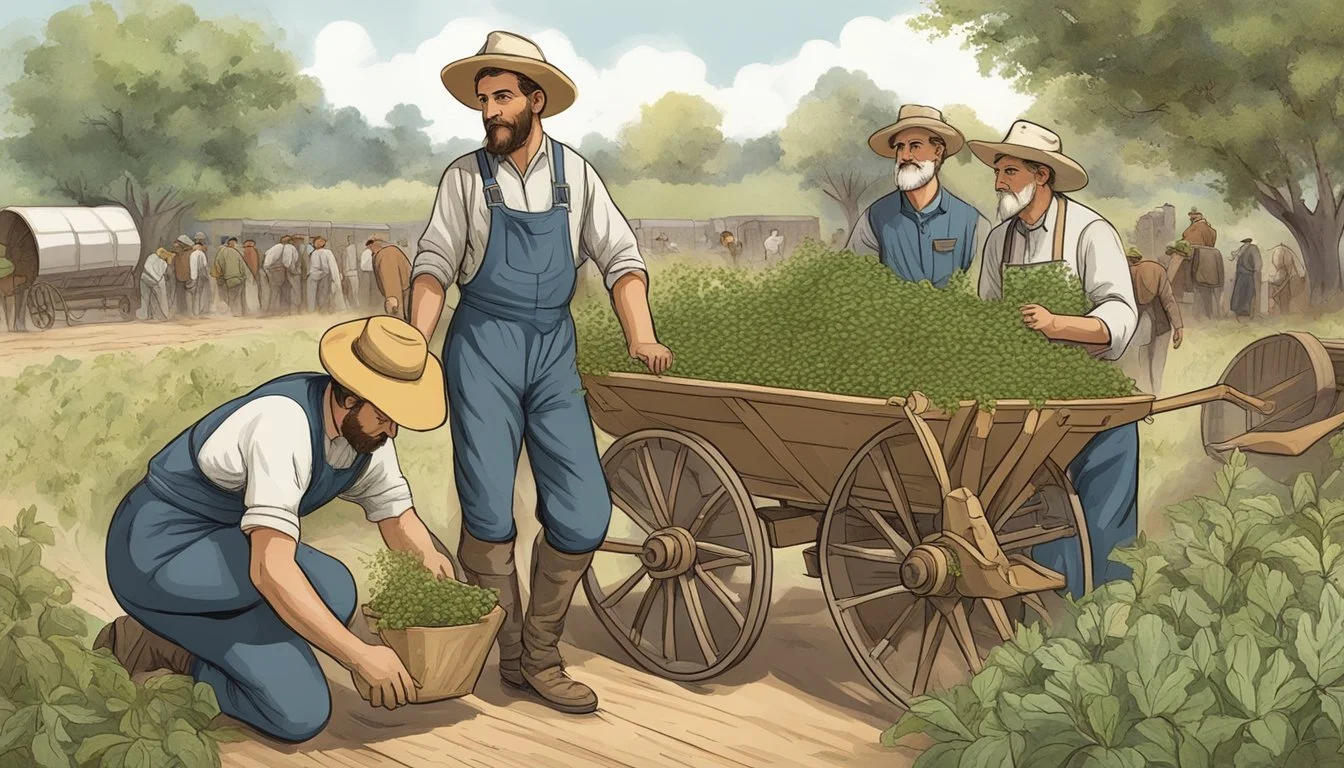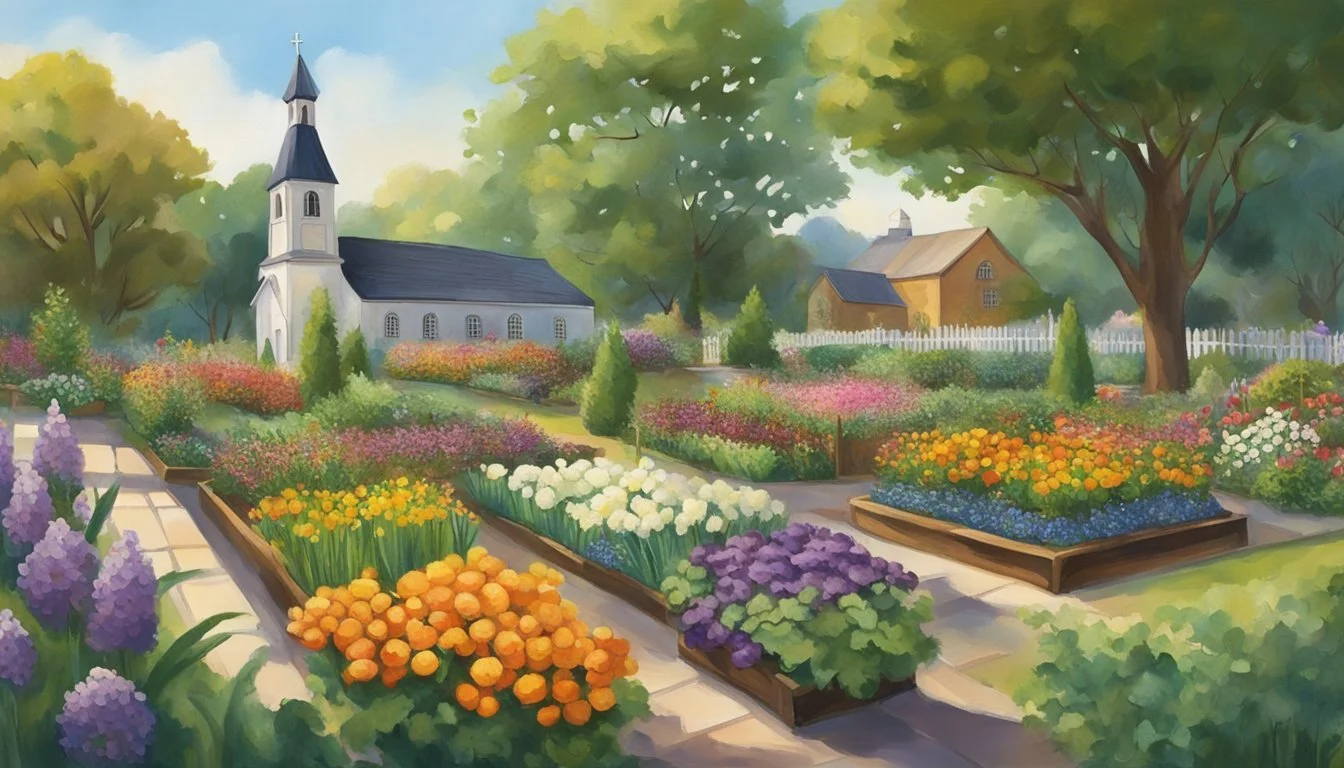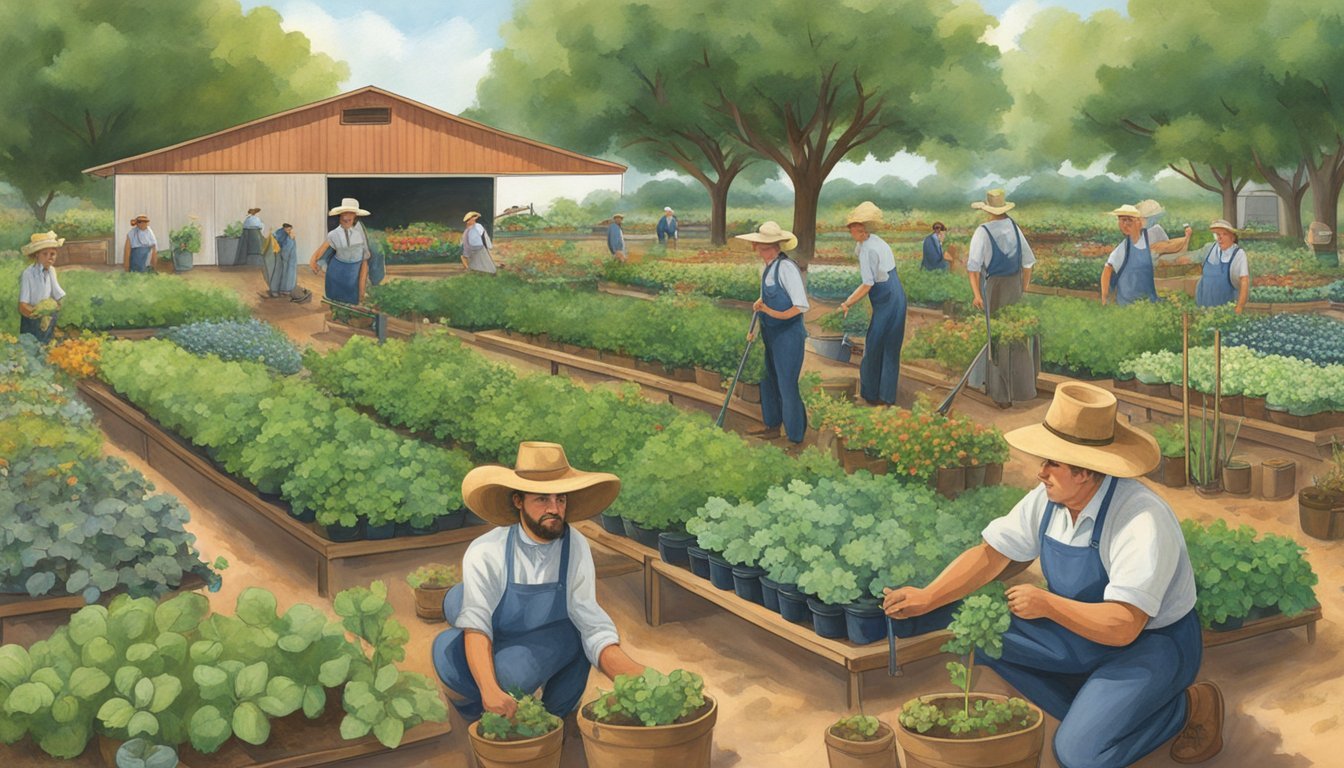German Texan Influence on Texas Horticulture
Roots and Growth of Cultural Gardening Practices
German influence on Texas's horticultural practices is a testament to the state's rich cultural tapestry. Following the substantial waves of German immigration in the 19th century, these settlers brought with them a vast array of gardening traditions that would leave an indelible mark on Texan soil. The early German Texans were largely responsible for introducing European horticultural techniques and plant species to the region, which they skillfully adapted to the unique climate and landscape of Texas.
The practical approaches to gardening and farming melded with the aesthetics of German landscaping, giving rise to distinctive Texan gardens that were both functional and visually appealing. Their strong affinity for vegetable gardens, stemming from a need for sustenance, coexisted with an appreciation for ornamental plants around their homesteads.
These horticultural practices have been sustained and integrated over time, becoming an integral part of Texas gardening culture. Symposiums, festivals, and educational literature continue to celebrate the German influence on Texan horticulture, ensuring that these traditions thrive alongside native and modern landscaping trends within the state.
Historical Arrival and Settlement of German Immigrants in Texas
German immigrants have played a significant role in the cultural and horticultural development of Texas. Their arrival and settlement patterns have laid the groundwork for a unique German-Texan culture, particularly evident in the state's central region.
Early Migration and Land Grants
The wave of German immigration to Texas began in the 1830s, shortly before Texas gained independence from Mexico. Johann Friedrich Ernst, often considered the first German settler in Texas, received a land grant in 1831 and wrote letters back to Germany praising the region. His positive accounts and the land grant policy of the time encouraged fellow Germans to pursue a new life in America. This influx was facilitated by societies like the Adelsverein, organized by German nobles to promote the emigration of Germans to Texas.
Key Figures: Johann Friedrich Ernst
Organizations: Adelsverein
Formation of German Communities and Towns
Upon arrival, German immigrants began forming tight-knit communities that would become the hallmark towns of Central Texas. New Braunfels and Fredericksburg were established in the 1840s, central to the so-called German Belt. The foundation of these towns created ethnic enclaves, and they quickly became hubs for incoming German settlers.
Important Settlements:
New Braunfels
Fredericksburg
Boerne
Schulenburg
Chain Migration and Expansion of German-Texan Areas
Chain migration played a critical role in expanding German influence across the state. As early settlers established themselves, they wrote back to their homeland, encouraging others to join them, which led to the growth of the German Belt across south-central Texas. Settlements such as Luckenbach and Boerne emerged, further extending the German cultural landscape. During the 19th century, German immigrants also settled in cities like San Antonio, which by 1880 had a population that was one-third German. Despite the interruption caused by the American Civil War, German immigration resumed and intensified afterward, reflecting the persistent and growing German presence in Texas.
Migration Patterns: Chain migration
Cultural Impact: Persistent German-Texan culture within the state
Influence of German-Texan Culture and Language
The German-Texan influence on horticulture and gardening reflects not only in the physical landscapes of areas like Fredericksburg but also mirrors in the linguistic and cultural heritage.
Preservation and Adaptation of German Culture
In Central Texas towns such as Fredericksburg, Boerne, and New Braunfels, the German culture is meticulously preserved and adapted. Public gardens and private landscapes echo German design aesthetics and plant species selections. A notable example is the local inclination toward cottage gardens, which originated in Germany and emphasize a mix of flowering plants and edible vegetation.
Fredericksburg: Keeps German horticultural traditions alive in community planning.
Central Texas: Features numerous public gardens that display German influence.
Texas German Dialect
The unique Texas German dialect is a linguistic testament to German influence in Texas. Developed from the various dialects of the immigrant population, it became widely spoken in communities across the Hill Country. Though its use has declined, efforts are in place to document and preserve the language.
Key Areas: Fredericksburg, New Braunfels, Boerne.
Dialect Influence: Visible in place names and plant names within Texas horticulture.
Impact on Texas Music and Festivals
Germans in Texas have also left a significant mark on local music and festivals. Events such as Wurstfest in New Braunfels and Oktoberfest celebrations reflect the region's German heritage. These festivals often feature traditional German music, which influences the regional soundscape and the communal spirit associated with horticulture and gardening gatherings.
German Music: Often performed at horticultural events in Texas.
Festivals: Serve as a platform for sharing German horticultural practices and traditional decorations.
German-Texan Contributions to Agriculture and Horticulture
German-Texan settlers brought with them a rich tradition of farming and viticulture, deeply influencing Texas's agricultural landscape. They introduced innovative farming techniques and new crops, and played a pivotal role in the growth of Texas's wine industry.
Agricultural Practices and Innovations
German immigrants in Texas utilized the fertile lands of Texas Hill Country to enhance agricultural productivity. They applied knowledge from their homeland to adapt to the local climate and conditions. Irrigation methods improved, and crop rotation practices were implemented to maintain the health of the soil. German-Texans also played a part in the development of ranching, combining their European techniques with Texan practices to raise and manage livestock more efficiently.
Introduction of Specific Crops and Techniques
The introduction of specific crops by the German settlers diversified Texan agriculture. They brought European varieties of corn and wheat, which thrived in the Texan soil. The food culture of Texas was enriched by these new ingredients, with corn becoming a staple in both Texan and German-Texan cuisines. They also introduced horticultural techniques, including orchard farming, and even the concept of kitchen gardens which became common in Texan homes.
Development of Texan Wine Industry
German influence was instrumental in the development of the Texan wine industry. Settlers from wine-growing regions, particularly those from areas around Munich, used their expertise to cultivate vineyards. They began producing wines that would be the foundation for what is now a flourishing industry, with Texan wineries gaining a reputation for quality. Recognizing the similarities between the Texas Hill Country and certain wine-producing areas in Germany, these vintners planted traditional grape varieties and established some of the state's first wineries.
German Architectural and Aesthetic Impact on Texas
The considerable German influence in Texas is exemplified in the distinct architectural and aesthetic styles prominent in the Hill Country, towns like Fredericksburg and New Braunfels, and the King William neighborhood in San Antonio, where the legacy of German Texans is ingrained in the built environment.
German-Texan Architectural Styles
In Texas, the German settlers introduced a range of architectural styles that were adapted to the local climate and available materials. They often constructed vernacular houses, which blended traditional German designs with the necessities of Texan landscape. Fredericksburg, for instance, is known for its Sunday Houses—small, often one-room, homes that rural residents used when visiting town for supplies and church services. New Braunfels and Boerne also feature architectural elements such as fachwerk, a framework of timber with infill, which is a distinct characteristic of German architecture. Additionally, the Hill Country boasts several limestone houses with steeply pitched roofs, reflecting German building traditions modified for the Texan environment.
Influence on Texas Domestic and Public Spaces
German influence extends beyond private abodes to public spaces within Texas. Houses in historic German-Texan areas commonly showcase meticulous decor, including the use of local materials and blending of traditional German styles with Texan elements. This is apparent in the King William neighborhood in San Antonio, where affluent German merchants built opulent homes that reflected their prosperity and taste. German design principles also influenced the layout of towns, with wide streets and well-organized public spaces, emphasizing both utility and beauty. Gardens and outdoor spaces were often meticulously planned, combining German horticultural sensibilities with the Texan landscape, revealing a deep appreciation for structure and nature imbibed within the local culture.
Social and Religious Life of German Texans
The German Texans maintained a vibrant community life through organizations known as Vereins and upheld distinct religious practices that left a significant imprint on the state's cultural landscape.
Community Life and Vereins
German immigrants in Texas established a variety of Vereins, which are clubs or societies, to maintain their culture and provide mutual support. In Central Texas towns such as Comfort and San Marcos, Vereins played a critical role in social affairs, fostering a sense of community. They organized educational, musical, and social events that helped maintain German traditions. These societies also served practical functions, such as providing aid to members in need, and were essential in preserving the German language and customs amidst the broader Texas living experience.
Religious Practices and Church Influence
Religion was a cornerstone of German-Texan life, with many of the German immigrants being Protestant. They established churches throughout Texas, which became hubs for the German community. The influence of these churches extended beyond religious practices, affecting aspects of day-to-day life and community cohesion. Religious groups often organized social events and contributed to a shared moral framework. In towns across Texas, particularly in regions with high concentrations of German-Texans, churches were instrumental in shaping the social fabric and served as a reminder of the homeland they left behind.
German-Texans in Texas Society and Politics
German-Texan heritage has played a pivotal role not only within Texan horticulture but also within the broader society and political landscape; their contributions have had lasting impacts on education, politics during the Civil War, and enduring representation in Texas.
Contribution to Education and Institutions
German immigrants recognized the importance of education and established numerous institutions and schools in Texas. An exemplar of this is the significant role they played in creating public schools and colleges. During the 19th century, German-Texans founded some of the first institutions of higher learning and were instrumental in the development of a public school system. They upheld a rigorous educational standard, which was often bilingual, reflecting their heritage. Their contributions extended to the University of Texas at Austin, where German influence is noted in its early curriculum development.
German Texans During the Civil Wars and Prejudice
During the American Civil War, the loyalty of German-Texans often fell with the Union due to their liberal and anti-slavery views. However, this stance placed them at odds with many other Texans, resulting in a complex relationship during and after the war. Post-war, during World War I, German-Texans faced significant anti-German sentiment. Legislation such as House Bill 304 was enacted in 1919, condemning the use of the German language in educational institutions. Despite these challenges, German newspapers and advocacy from groups like the German-Texan Heritage Society provided support and helped protect the community’s cultural identity.
Contemporary Representation and Influence
Today, German-Texans continue to be a vital part of Texas society and politics. The legacy of their early newspapers still echoes in the representation of German-Texans in Texas media and politics. A reflection of their enduring clout is seen through their involvement in cultural preservation along the Llano River and other regions. While the initial wave of German influence has integrated with broader Texan culture, modern German-Texans remain active in civic life, contributing to a diverse and representative political landscape.
Legacy and Preservation of German-Texan Heritage
The influence of German-Texans on Texas horticulture is a testament to their deep-rooted presence in the state. Known for their diligent work ethic and expertise in farming and gardening, they brought with them a wealth of knowledge that has left a lasting imprint on Texas landscapes.
Preservation Efforts:
The German-Texan Heritage Society actively endeavors to preserve the unique elements of their culture, including their horticultural practices. They encourage the growth and maintenance of native Texan plants and integrate German customs into local gardening methods.
Cultural Integration:
German-Texan horticultural techniques often stress the importance of seasonal planting and sustainability, aligning closely with the agricultural customs from their homeland. These methods are passed down through generations, ensuring that the legacy of German influence continues to flourish in Texas gardens.
Architectural Imprint:
One cannot discuss the influence of German-Texans on local horticulture without mentioning the distinctive architectural styles of their gardens and the utilitarian, yet beautiful, design of their farm buildings. Inspired by German aesthetics, these structures often incorporate lush, well-tended gardens that reflect the meticulous nature of their creators.
Educational Impact:
German-Texans have been pivotal in advocating for educational programs that focus on the preservation of gardening heritage. They champion the inclusion of traditional horticultural practices in educational curricula to foster an appreciation for their contributions among all Texans.
In summary, the commitment to preserving German-Texan horticultural customs provides a rich cultural tapestry that is integral to the state's diverse heritage. Through the conservation of these customs, the German-Texan Heritage Society safeguards a vital component of Texas's cultural identity.









